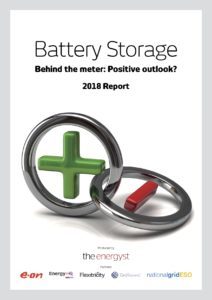Demand-side response aggregators are becoming suppliers and vice versa. Can the two parties also collaborate to help customers maximise the value of their flexibility and where are the biggest prizes? The Energyst asked Flexitricity and Npower for their thoughts

Wayne Mitchell, director of Energy HQ at Npower Business Solutions
Can parties with competing agendas (aggregators and suppliers for example) maximise value for customers while minimising whole system impacts/costs?
“Yes, definitely. I would challenge the notion that aggregators and suppliers can’t collaborate. Suppliers who have aggregation capabilities (like ourselves) will actively participate in the DSR market. However, where our customers are already in partnership with other aggregators, we can work together to generate additional value for their flexibility.
“After all, it’s in the best interest of the customer if aggregators and suppliers work together – it means they can access more markets, generate more value per kW and de-risk their business case.
“In the current policy landscape, with the ‘Targeted Charging Review’ impacting DSR fundamentals like winter peak cost avoidance, the only certainty is change. We’re already seeing customers reducing their flexibility – or considering it – based on changes in the market.
“It’s vital for consumers to become more flexible, to support the UK energy system. So, the industry should be working to ensure customers get maximum value for their contribution.
What are the challenges thrown up by customers taking an action (how does it affect suppliers’ positions and what is the upshot)?
“It comes down to knowledge and sharing knowledge. The real question is, ‘what is the impact of a customer taking an action a supplier doesn’t know about or isn’t aware of?’
“A supplier can’t help a customer generate value from flexibility if they don’t know it is happening. There is a benefit to the supplier hedging customer flexibility in the short-term wholesale markets and only the supplier (because they hold the customer position) can do this. This is needed for the customer to get the best result from their deployment, so we need to encourage an industry openness. There is also a risk the supplier could penalise the customer for breaching volume tolerances on contracts, and our experts at Energy HQ, Npower Business Solutions, try hard to work with our customers to ensure this doesn’t happen.
“As an example, we traded over 100MWh of volume for customers at prices exceeding £150/MWh in short term markets in one December day. That essentially meant these customers received extra value for completing an action they were delivering anyway. This only worked because we were aware these customers would be delivering DSR – our experts are able to generate this extra value for any customer in our portfolio. Our challenge is gaining visibility of customer action.”
Are there potential ways in which different parties could work more closely to address those challenges?
“Honestly, as a supplier, we’re conscious aggregators don’t want to tell us who within our portfolio they are working with as it could lead to competition. We just want to know what’s going on across our portfolios or have a dialogue with those delivering the services, then we can ensure customers aren’t being penalised and reduce their business case risk, while maximising revenues.
“The current gap is communication – and once we start talking more as an industry we can deliver more value for customers and reduce our risk as a supplier, that’s why the door is open from our side.”
Wholesale markets or balancing mechanism: Is there a ‘best bet’ to optimise flexibility revenue?
DSR business cases are built on revenue stacking. We recommend that where any revenue streams are not mutually exclusive, they are stacked and incorporated into the overall asset strategy, this is true for any services including short-term Wholesale Market Access and the BM.
“If pushed to pick one, I would say that the short-term Wholesale Markets provide the more tangible opportunity for the majority of DSR providers. These markets were worth over £6bn last year and with 15 years market experience through our Award Winning Optimisation Desk, we believe we are well placed to give our customers a share of this. In comparison, the BM totalled £350m last year, which is tangible, but nearly 20x lower than the N2EX and APX markets combined. The other critical point is that these markets can generate additional value for activity a customer is already completing. For example, by being made aware of a customer’s intention to respond to triad calls, we can generate around £3k/MW of additional benefit this winter.
Other benefits include:
- Trades are completed prior to an event so there is absolute certainty of the value your response will deliver
- We can manage and monitor delivery through billing data so there’s no need to have on-site controls or site visits
- Trades down to 0.1MW mean customers don’t need to be aggregated and value is transparent
- Market Access can work with both high and low market (including rare negative wholesale price events)
- You actually have two opportunities to trade volume in either the day ahead or within-day markets, which gives customers the best chance of getting the deal done.”

Alastair Martin, founder and chief strategy officer, Flexitricity.
Can parties with competing agendas (aggregators and suppliers for example) maximise value for customers while minimising whole system impacts/costs?
“For the right customer, supply and aggregation can work well together. As an aggregator, Flexitricity has always considered it its main duty to represent the customer into the flexibility markets. As a business energy supplier, our job is to represent the customer into the energy markets as well.
“A conflict could arise where suppliers also trade their own books. Whether they are trading against their own generation fleet or their own speculative positions, there’s a natural potential for conflict with the customer’s own ability to offer flexible services.
“But perhaps the biggest conflict is with tradition, embodied in business processes that were designed when customers didn’t know very much about the energy they were buying. We’ve been repeatedly taken aback when suppliers’ apparent enthusiasm for flexibility has foundered on the rocks of their own middle-office strictures.
“To minimise whole system impacts and costs, the only thing that works is an open market with maximum information available to those who are in a position to act on it. Nowadays, that’s not only power stations or trading houses – it’s customers as well.”
What are the challenges thrown up by customers taking an action (how does it affect suppliers’ positions and what is the upshot)?
“In market-speak, if a customer delivers a reserve service by turning down load or turning up generation on request from National Grid or a distribution network operator, it “goes long”. In the old world when prices were fixed regardless of consumption, this long position immediately landed on the supplier, who would end up sitting on an excess of electricity, giving them an imbalance for which they would be paid – generally quite well.
“In today’s hodge-podge of imprecisely-worded volume tolerance arrangements, it’s not always clear where the extra ends up. It’s equally hard to figure out who is losing out and who is making extra gains. Be that as it may, it’s been decided, through Project TERRE and a code change known snappily as P354, that volumes will be corrected for certain reserve services. If a customer delivers a STOR call, the energy of that will be calculated (with the aggregator’s help) and taken off the supplier’s account. This is what the major suppliers wanted, arguing that if they’d bought electricity for a customer, they’d be happier if the customer was deemed to have used it in some way.
“It’s between the supplier and the customer to sort out the effect of this through the supply agreement. That’s if they want to – they can just leave it to ordinary fixed-price or volume tolerance risk management. One thing Flexitricity argued for – and achieved – from the P354 discussions was anonymity for customers delivering flexible services. Suppliers need customers’ consent before they access customer-specific information about STOR calls and the like. This is to prevent suppliers from restricting or controlling customers’ access to the flexibility markets.
“Before granting such access, I’d encourage customers to ask three penetrating questions of their suppliers. These are:
- Do you have your own power stations or traded book which is playing against me in wholesale energy markets, and if so, how are you protecting my interests?
- Can you please write down on a piece of paper exactly how my volume tolerance and imbalance are calculated? No arm-waving, please; I want the maths.
- Since I know my business better than you do, and since I can easily get independent advice on the energy markets, how about just giving me straight pass-through contract so that I can manage my own risks and sell my own flexibility direct?”
Are there potential ways in which different parties could work more closely to address those challenges?
“This is about listening to the customer.”
“Electricity is complicated, but so are the business operations of energy customers and small generator owners. Rather than forcing energy managers to interpret trader gobbledegook for their finance directors and operations managers, it might go better if energy suppliers designed their back- and middle-office functions to suit the ways in which customers run their businesses.”
“It’s also about speaking clearly. Witness the ongoing debate about network charges – how many customers knew what the demand residual was until they heard that it was going to be revised? This one is as much for Ofgem and the network companies as it is for suppliers and aggregators.”
“Customers have been paying the residual for years, and soon they will pay it differently – with profound effects on their businesses. Time-of-use operations – avoiding red periods and triads, for example – may soon give way to more active load-shifting. In all things flexibility, even in flexibility itself.”
Wholesale markets or balancing mechanism: Is there a ‘best bet’ to optimise flexibility revenue?
“The answer is ‘both’. There’s a broader question – what’s the best bet between energy markets, capacity, ancillary services like STOR, and new activities like TERRE? The answer to that one is ‘all of the above’.
“Most DSR companies accept that every site is different in capability, capacity and operational needs, and a tailor-made approach is required for each. What’s less well recognised is that every season is different. Next winter won’t be like this winter, and last summer wasn’t like the one before. This is partly a function of the ebbs and flows of market competition, but it’s also a result of the progressive transformation of the energy industry.
“Flexitricity’s first operational winter, ten years ago, was characterised by sudden events, especially trips at large nuclear stations. More recently, the nukes have been better behaved, and a lot of our activity has been about fine-tuning – smaller but more regular adjustments needed to balance wind variations or create headroom for frequency response.
“As markets change, value moves around. The right approach for a DSR customer is access to all of the opportunities which are relevant. Where’s there’s scope for reasonably regular flexible operation, or where the flexibility is two-sided, the balancing mechanism is a key component. Intraday and day-ahead trading are great where operational schedules can be adjusted in timescales of a few hours, and these activities can work very well with the balancing mechanism. More rigid loads may be better in more regimented ancillary services like committed STOR or firm frequency response.
“It’s the businesses with the broadest range of DSR participation which are best protected from market and regulatory changes, and which have the best potential to profit from the flexibility inherent in their own assets.”
 Flexitricity and Npower were co-sponsors of The Energyst’s 2018 Battery Storage report and conference. This exchange of views was borne out of discussion at the conference.
Flexitricity and Npower were co-sponsors of The Energyst’s 2018 Battery Storage report and conference. This exchange of views was borne out of discussion at the conference.
Download the storage report here.
Related stories:
EVs, smart charging and vehicle to grid services: Your views required
All DNOs commit to consider flex and energy efficiency over reinforcement
Co-located storage can bid into Capacity Market
Bloomberg: Bring on flex or pay and emit more
Ofgem’s targeted charging review: What’s the business cost impact?
2019: Time to understand your flexibility
Click here to see if you qualify for a free subscription to the print magazine, or to renew.
Follow us at @EnergystMedia. For regular bulletins, sign up for the free newsletter.



